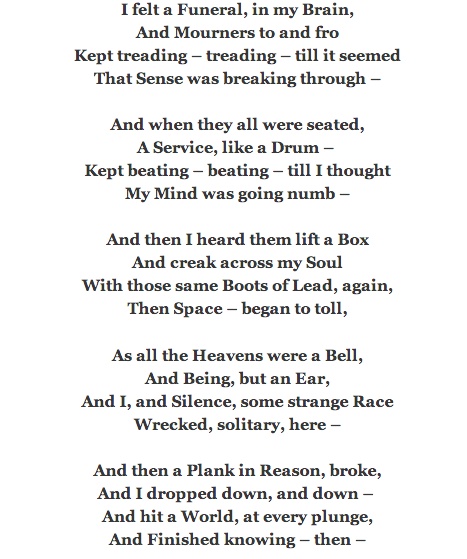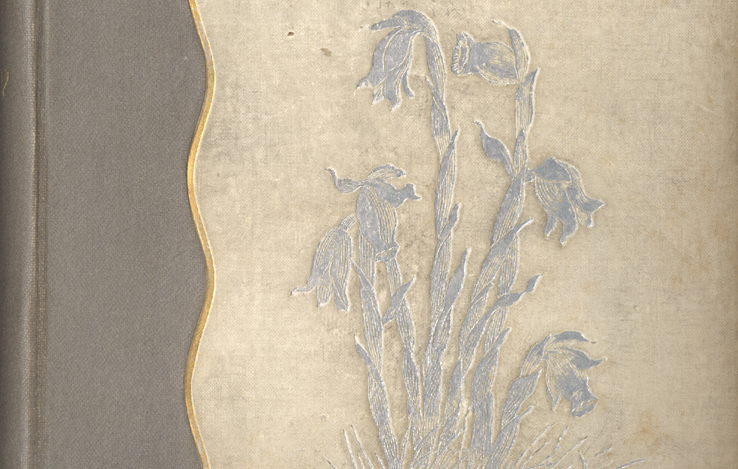In his first letter to a young poet, Rainer Maria Rilke mused, “Things aren’t all so tangible and sayable as people would usually have us believe; most experiences are unsayable, they happen in a space that no word has ever entered.” He finds himself confronted with the paradox inherent to most poetry, namely that it aims to express the inexpressible. A poet counterintuitively uses words in order to enter that “space that no word has ever entered,” the infinite distance that lies between the words themselves and the ideas they convey. In a technique that is comparable to a Zen Buddhist kōan, Emily Dickinson attempts to traverse this poetic abyss by embracing the paradox rather than resolving it; she allows multiple interpretations to coexist in tandem within the same poem, like complementary notes in a harmony, in order to transcend the limits of language and say the unsayable.
Zen Buddhists believed that dichotomies such as good and bad, truth and falsehood, phenomenal and spiritual, could not exist without each other. As a result, they felt it was necessary to embrace both sides of the dichotomy and allow them to exist simultaneously. In the course of their teachings, Zen masters would often pose riddles to their students called kōans, or apparently contradictory statements on which the students were expected to meditate. But the masters did not expect their students to find a straightforward “answer” to the paradox. On the contrary, they encouraged their pupils to accept the coexistence of dualities to the point that they are essentially no longer dualities.
One of the most famous Zen kōans reads: “Two hands clap and there is a sound, what is the sound of one hand?” This kōan is symbolic of the “identity of opposites”; rather than giving a dualistic answer to the paradox, the students endeavored to embrace the incongruent concepts until they were united as two opposing sides of one concept.
The common Western understanding of the word “kōan” is “meaningless statement” or “unanswerable question,” but in Zen Buddhism, these statements are far from meaningless, and the questions are not unanswerable but ineffable. They have answers that are not easily expressed through language, and indeed may resist language entirely.
While Dickinson did not practice Zen Buddhism, her poetry shows a kinship with the tenets of the religion. She creates multiple cohesive readings within each poem that exist simultaneously, and the resultant tension contributes to a meaning that is greater than the sum of its parts. This can be seen in Dickinson’s poem “I felt a Funeral, in my Brain”:

Multiple interpretations of this poem exist in tandem, creating a tension between the readings and making every word more charged with meaning. The most immediately apparent is a depiction of the final stages of a descent into madness; her mind is “dying” in the sense that it is losing all capacity for reason and sanity. According to this analysis of the poem, the speaker feels as though she is watching a funeral of her brain and is attempting to forestall it when she says “Sense was breaking through,” analogous to the ghost of a dead person trying to intervene at their own funeral and tell her loved ones that she is still alive.
The drum beating in the second stanza that causes the speaker’s mind to “go numb” is representative of the cacophony inside an unhinged mind, while the numbness itself implies eventual catatonia. The repetition of the words “treading” and “beating” support this reading, not only because they emphasize the noise in her brain, but also because repetition and thinking in circles are characteristic of a psychotic break. The speaker’s disruptive thought patterns are emphasized by the dashes surrounding these words, as they give the impression that the noise continues in the resulting caesura, and then begins again in the preceding caesura.
Then, the mourners leave with the coffin, or the last vestiges of her sanity, and all of space seems to make the noise that started rhythmically, but has since devolved into chaos. Silence joins her in her solitude, as her insanity has permanently separated her from the cacophonous world. Finally, the last plank in the wood of her sanity breaks, and she descends into the abyss of madness.
An alternative reading of this poem is a despairing view of the afterlife: The speaker is literally dead and is trying to prevent herself from falling into the much-feared void of a lack of an afterlife—or perhaps even hell. This reading is corroborated by the fact that the mourners carrying the coffin are “creak[ing] across [her] soul,” as well as the speaker’s apparent estrangement from heaven in the fourth stanza; she is hearing the bells of heaven but is apart from it, and in fact has silence all around her.
According to this reading, she may be viewing her own funeral in the first stanza, and “Sense,” rather than referring to sanity, would refer to sensation, or a return to the body. The speaker is trying to repossess her body and stop both the funeral and the dying process. Then, in the fourth stanza, she hears the sounds of Heaven, but acknowledges that she is irrevocably apart from it, adding more poignancy to the statement “Wrecked, solitary, here.” The adjective “wrecked” makes it more likely that she is going to Hell, as it evokes the word “wretched,” an adjective often used to describe the condemned. However, the fact that there is silence around her seems to support the reading that the afterlife consists of nothingness (which, again, is a special kind of hell in its own right). And further, the dash after the word “here” seems to associate the speaker’s final resting place with an emptiness, or a nullity. Moreover, the contention that she has “finished knowing” implies that all ability to think or feel is lost to her. The speaker’s description of “hit[ting] a World, at every plunge” also seems to strengthen the overall reading of a depiction of the afterlife, as she is not only losing this world (as would be the case if she were descending into madness) but every possible world.
The related but distinct readings of the poem that can exist concurrently represent the opposing forces that strain towards each other to create a harmonious impression. Just as a kōan is resolved with “one hand clapping,” there is a unified meaning to the poem, but in order to derive it, the reader must consider all possible worlds that the poem is building and negotiate the resultant tensions.
This poem can be read as akin to a Zen paradox, as Dickinson creates multiple holistic interpretations within one poem, which results in the ability of the reader to interpret every line, every word in different ways. However, this technique is slightly more akin to a dualistic answer to a kōan, while the enlightened answer would involve the exploding of dualities into a single reconciled contradiction, similar to “one hand clapping.” In this sense, the Dickinson poem that is most analogous to a zen kōan may be “There’s a certain slant of light”:

Unlike “I felt a Funeral, in my Brain,” this poem doesn’t necessarily maintain multiple and equally cohesive readings. Rather, it mirrors the paradoxical nature of melancholy by delicately balancing positive and negative connotations. The first line is primarily focused on the concept of light, which has an undeniably positive connotation, but is equivocated with the usage of the word “slant.” Similarly, the second line juxtaposes two words with slightly different connotations in order to create a tense equilibrium; the word “winter” is associated with darkness and cold, while the word “afternoon” is associated with light and warmth. The two words together add up to more than the sum of their parts; they create the impression of a light but cold afternoon, like the bright white of the sky when it snows.
The image of a “slant of light” on “winter afternoons” could be either peaceful or melancholy (or both), and the word “oppresses” in line 3 seems to support the latter. But the comparison to “cathedral tunes,” rather than, say, dirges, implies a sublimity as well, as though the sadness itself allows for a “hefty” emotional experience. This reading is further substantiated by the paradoxical concept of “Heavenly Hurt.” It seems counterintuitive that pain could be “heavenly,” but the alliteration and the capitalization of both words effectively connects the two ideas, and once again implies that metaphysical pain, for which “we can find no scar,” can help us achieve transcendence.
The third stanza continues to maintain this tension; for example, the word “imperial,” used to describe the “affliction” of this melancholy slant of light, can carry a connotation that once again categorizes the light as “oppressive,” as its primary definition is domineering or authoritarian. But the word can also mean majestic or exalted, and as a result, this one word exemplifies the tension of the entire poem. The following statement that the affliction was “sent us of the Air,” further supports the reading of the word as meaning “elevated,” as it implies that the light is sent from a place that transcends Earth, possibly Heaven. And since the word “affliction” can refer to either depression or physical illness, the light is associated with both melancholy and a Heaven-sent disease, akin to a Biblical plague, which has a negative but distinctly lofty connotation. Furthermore, this line rhymes the word “air” with “despair,” which associates the two concepts with each other, and once again emphasizes that psychological pain can be spiritually enlightening.
Finally, the fourth stanza sees a shift in tone, and makes the sublime nature of the “light” and associated sadness much more explicit. The arrival of the light is powerful enough to command the attention of the landscape and rarified enough to keep the shadows at bay. Here, the light seems to have a much more traditional purpose of driving out darkness, which is somewhat at odds with the rest of the poem. But the shadows aren’t leaving, they are simply “holding their breath” in awe. This confirms that the light does not simply have a dark or negative connotation, but a transcendent one. And then finally, when the light is gone, that sublimity is gone as well. In the final image of “the distance on the look of death,” the light’s departure is not associated with darkness, but emptiness. Melancholy may be painful, but it is also divine, and its absence does not lead to happiness, but a hollow neutrality. In the entire poem, but especially in this stanza, the subtly established opposing forces strike a harmony, and apparent contradiction gives way to a unified meaning that is created through constructive conflict.
The tension within these poems allows Dickinson to explore subject matter that resists straightforward explanation. The abstract concepts of death, melancholy, despair, Heaven, Hell, are all impossible to adequately describe in concrete terms. Dickinson’s poetry strives to be the manifestation of a concept, thought, or emotion, that which cannot be expressed, and at the same time must be expressed. She maneuvers around this paradox by incorporating paradox into her poetry, and, in the tradition of Zen Buddhism, resisting the urge to resolve these contradictions in a straightforward manner. Instead, she encourages the reader to embrace, and even love, dualities until they are no longer diametrically opposed, and allowed to coexist in harmony. Just as enlightenment is achieved by meditating on the true nature of a Zen kōan, the reader achieves a deeper understanding of Dickinson’s poetry by pondering her carefully negotiated tensions until that tension has dissipated into a unified and potentially sublime meaning.


Thanks for this amazing insight into Dickinson’s words. I would qualify all poems as koans and poetry as a spiritual practice. I keep thinking of Mallarmé ( sorry, I’m french) who, in my opinion, is very similar to Dickinson. Take a look at this sonnet : A la nue accablante tu
LikeLike